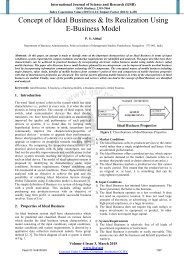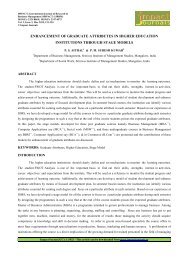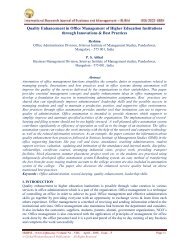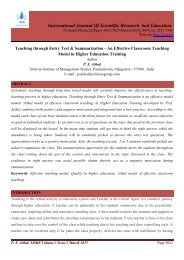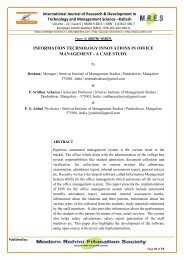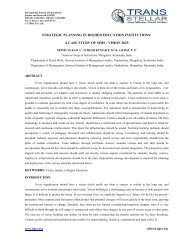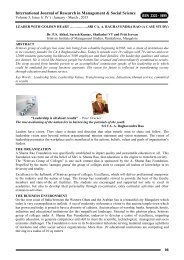How Innovations and Best Practices can Transform Higher Education Institutions : A case study of SIMS
Education has become competitive so as the educational institutions. In order to survive the competition, institutions have to improve the quality of their services. Changes in culture, aspiration and levels of skills required in securing employment for students, force higher education institutions today to rework on their educational models and add value to each and every aspect of their service. Innovations and best practices serve to enhance quality and add value. Srinivas Institute of Management Studies (SIMS), which combines technology, management and social service education has identified and implemented innovations and best practices to differentiate itself among the competitors and to add value in its educational services. In this paper, we have discussed innovations, small and big, develped indigineously and implemented during last four years. They are broadly classified under six key aspects namely "curricular aspects, teaching-learning and evaluation, research, consultancy and extension, infrastructure and learning resources, student support and progression, and governance, leadership, and management". The paper also contains some of the intitutional and individual faculty best practices having visible impact on the quality of higher education imparted by the institution. The best practices concern admission, fees, attendance, teaching, performance, skill building, employability, student involvement, collective learning, value addition, ensuring transparency, information dessimination etc. Finally two institutional best practices are elaborated with its aim of practice, underlying principles and concepts, particular contextual features or challenging issues that have had to be addressed in designing and implementing the practice, and its implementation, including its uniqueness in Indian higher education, evidence of success, identifying the problems encountered and resources required to implement the practice.
Education has become competitive so as the educational institutions. In order to survive the competition, institutions have to improve the quality of their services. Changes in culture, aspiration
and levels of skills required in securing employment for students, force higher education institutions
today to rework on their educational models and add value to each and every aspect of their service. Innovations and best practices serve to enhance quality and add value. Srinivas Institute of
Management Studies (SIMS), which combines technology, management and social service education
has identified and implemented innovations and best practices to differentiate itself among the competitors and to add value in its educational services. In this paper, we have discussed
innovations, small and big, develped indigineously and implemented during last four years. They are
broadly classified under six key aspects namely "curricular aspects, teaching-learning and evaluation, research, consultancy and extension, infrastructure and learning resources, student support and progression, and governance, leadership, and management". The paper also contains some of the
intitutional and individual faculty best practices having visible impact on the quality of higher education imparted by the institution. The best practices concern admission, fees, attendance, teaching, performance, skill building, employability, student involvement, collective learning, value
addition, ensuring transparency, information dessimination etc. Finally two institutional best practices are elaborated with its aim of practice, underlying principles and concepts, particular contextual features or challenging issues that have had to be addressed in designing and implementing the practice, and its implementation, including its uniqueness in Indian higher
education, evidence of success, identifying the problems encountered and resources required to implement the practice.
You also want an ePaper? Increase the reach of your titles
YUMPU automatically turns print PDFs into web optimized ePapers that Google loves.
International Journal <strong>of</strong> Management (IJM), ISSN 0976 – 6502(Print), ISSN 0976 - 6510(Online),<br />
Volume 6, Issue 2, February (2015), pp. 83-98 © IAEME<br />
enable a regular attentive student to answer without preparation ahead. By allowing to consult the<br />
books, students get rid <strong>of</strong>f fear for examinations <strong>and</strong> develop book reading habit.<br />
[Faculty 24]<br />
25. Exhibit Reality<br />
It is a simulation exercise aimed at showing the practicality <strong>of</strong> the subject learnt, which<br />
enables students in underst<strong>and</strong>ing the concepts better. Students are divided into groups <strong>and</strong> are made<br />
to exhibit various products or services. They would be going to various locations to learn <strong>and</strong> collect<br />
information. They would be exhibiting the products as well as presenting the unique features <strong>of</strong> the<br />
products <strong>and</strong> the various company policies on pricing, marketing, financing, etc.<br />
[Faculty 25]<br />
26. Learn a Word a Day<br />
The concept is aimed to enrich the vocabulary <strong>of</strong> students. Vocabulary is one <strong>of</strong> the<br />
bottlenecks coming in the way <strong>of</strong> the students to freely converse in English due to lack <strong>of</strong><br />
confidence. Enrichment <strong>of</strong> vocabulary <strong>can</strong> be achieved through a practice <strong>of</strong> learning one word a<br />
day. rigorous reading <strong>of</strong> news papers, abridged version <strong>of</strong> fictions <strong>and</strong> watching English talk shows<br />
<strong>of</strong> any topic are the ways to supplement this practice. But these measures are easier said than done so<br />
long the students have the hiccups in the diction i.e., their inability to arrange words for a piece <strong>of</strong><br />
talk.<br />
[Faculty 26]<br />
27. Divide <strong>and</strong> Learn Method<br />
This is a method <strong>of</strong> dividing an entire concept into smaller topics in order to make the<br />
students underst<strong>and</strong> the concepts. Simple problems are given to be worked out until students<br />
underst<strong>and</strong> the concepts <strong>and</strong> then move to difficult problems. Making students to underst<strong>and</strong><br />
practically is easier way <strong>of</strong> changing the mind set <strong>of</strong> students regarding the subject <strong>of</strong> <strong>study</strong>.<br />
[Faculty 27]<br />
28. Each one Teach One<br />
The present day students are more techno-based rather than <strong>study</strong>- based. Therefore they are<br />
disinterested in listening classes as passive recipients. Through this practice, students interest in<br />
studies is enhanced by assigning opportunity to fellow students to learn from each other under the<br />
supervision <strong>of</strong> the teacher.<br />
[Faculty 28]<br />
29. Counselling <strong>and</strong> Case <strong>study</strong> analysis<br />
Apart from the university prescribed syllabus, each module is taught through one appropriate<br />
<strong>case</strong> <strong>study</strong>. Wherever possible, practical insights are integrated through industry visits, videos, role<br />
plays etc. During the evaluation <strong>of</strong> the answer scripts, comments are made on how to improve the<br />
answers through incorporating these learnings. This gives better feedback on the intended focus<br />
areas in each area. Student counseling activity is undertaken as a follow-up to this on a weekly basis<br />
to monitor the progress.<br />
[Faculty 29]<br />
VI. ELABORATION OF TWO BEST PRACTICES<br />
(a) Comprehensive Performance Management System<br />
1. Title <strong>of</strong> the Practice<br />
Comprehensive Performance Management System through faculty self-evaluation & rating<br />
by head <strong>of</strong> the institute.<br />
92




